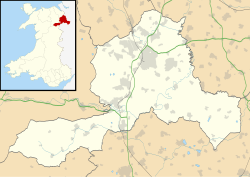(Llansantffraid) Glyn Ceiriog
| |
|---|---|
 Centre of Glyn Ceiriog, view from the Glyn Valley Hotel | |
Location within Wrexham | |
| Population | 1,040 (2011) [1] |
| Language | English Welsh (48.3% of population) [2] |
| OS grid reference | SJ205384 |
| Community |
|
| Principal area | |
| Preserved county | |
| Country | Wales |
| Sovereign state | United Kingdom |
| Post town | LLANGOLLEN |
| Postcode district | LL20 |
| Dialling code | 01691 |
| Police | North Wales |
| Fire | North Wales |
| Ambulance | Welsh |
| UK Parliament | |
| Senedd Cymru – Welsh Parliament | |
| Website | glynceiriog.org.uk |
Glyn Ceiriog (Welsh : Glynceiriog [3] ) is the principal settlement of the Ceiriog Valley and a community in Wrexham County Borough, north-east Wales. Glyn Ceiriog translates simply as Ceiriog Valley, though there are other villages in the valley. The village and community is technically known, in traditional Welsh naming style, as Llansantffraid Glyn Ceiriog or sometimes Llansanffraid Glyn Ceiriog, which means church of St Ffraid (the Welsh name of Saint Brigid of Kildare) in the Ceiriog Valley, but it has come to be known simply as Glyn Ceiriog, or even Glyn for short. The name Llansanffraid is now more associated with other villages of the same name.
It is in the Clwyd South Senedd constituency and the Montgomeryshire and Glyndŵr UK parliamentary constituency.
A former slate mining village, it lies on the River Ceiriog and on the B4500 road, about 6 miles (10 km) west of Chirk. It is south of Llangollen.





